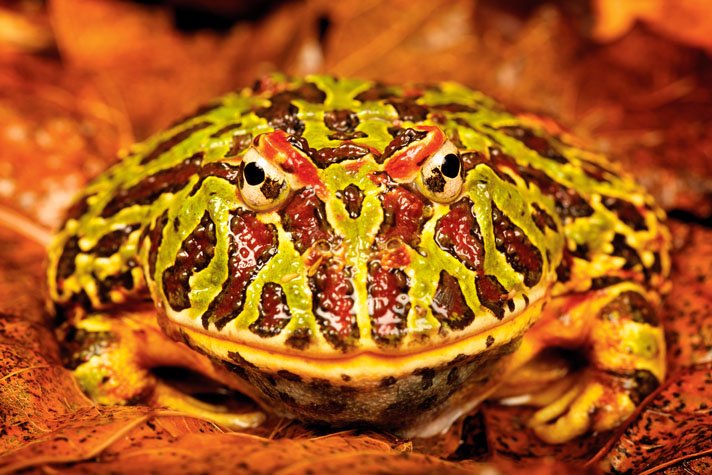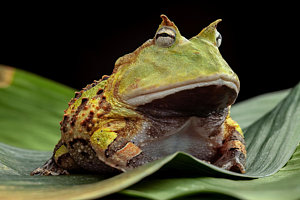South American Horned Frog (Pacman Frog)
The Pacman frog comes from South America. Spending most of their time in a humid environment among damp leaf litter (perfect for camouflaging themselves in). They live between 7 – 10 years. Pacman frogs are famous for their cartoon features but however cute they look any prey that walks by is a fair game for this hungry frog.

How did they get the name Pacman?
The South American Horned frog got its name due is characteristically round, large shape mouth. Which looks a lot like the video game character Pac-Man.
What does a Pacman frog look like?
Pacman frogs are earthy coloured so that they can blend in with their surroundings. They have a round, large shaped mouth as well as a round body. The Pacman Frog’s eyes are beady and situated on top of their head. The most surprising thing about these cartoon looking frogs are their teeth – the frog only has teeth only on the upper jaw. When the frog is fully grown they get strong enough to take the skin off a human’s finger.
What animal class are they?
The Pacman frog is from the animal class – Amphibian (Amphibians are ectothermic, tetrapod vertebrates of the class Amphibia)
Where do they come from?
The Pacman Frog comes from South America (hint in why the official name is ”South American Horned Frog”)
What do Pacman frogs eat?
Pacman frogs eat crickets, roaches, fish, worms and even small mice. The amount of food you feed them is based on the size and temperature of the frog.
Is a Pacman frog a good pet?
Pacman frogs have lots of good qualities such as they don’t need a very large cage since they are not very active, they are also easy to feed since they are not fussy eaters. If you are looking to get a Pacman frog as a pet you should look for a clear-eyed, blemish-free frog, this is because Pacman frogs very easily become ill. The best way to know if you pick a healthy frog is by watching it eat – very rarely will a Pacman frog refuse its food.
However, watch out these frogs have been known to bite if they feel threatened and are also not good for handling.
How do you tell the difference between a male and a female?
A male frog will “chirp” and “croak” a lot more often than a female Pacman frog. Most male Pacman frogs have spots on their chest, while the female is a lot bigger than the female frog.
How do you look after a Pacman frog?
- Housing your frog should be easy, as they do not need a big enclosure (due to them not being very active). Just make sure you lay down sphagnum moss, peat moss or coir deep enough for the Pacman to burrow in.
- Make sure the Pacman enclosure is not in direct sunlight (you don’t want them to overheat). They like an average room temperature (18C – 29C) and at least 12 hours of light/dark.
- Pacman frogs absorb moisture through their skin in order to drink water. Therefore, you need to give your frog a shallow bowl of chlorine-free water (note: tap water contains chlorine, the best thing to do is boil tap water and wait for it to cool down to remove harmful chemicals). These frogs don’t swim; they can drown in deep water.
- Pacman’s like eating live food, so be careful they don’t get your fingers! Pacman frogs eat crickets, roaches, fish, worms and even small mice
- Make sure you clean your frog’s tank at least once a week. Wash your hands before handling your Pacman as human oil can be toxic. Clean the tank with hot water (no soap as that’s harmful to your frog)
- Lastly, you should always make sure your frog’s habitat is damp. When a Pacman becomes dehydrated his outer skin becomes dry and tough. Rehydrate him and he’ll shed his outer skin and eat it.
To book a school animal workshop from a Pacman frog just contact Animal Club via the website
Questions (skim read through the text above to answer the questions)
- Why is the South American Horned Frog nicknamed the ‘Pacman Frog’?
- What colour is the Pacman frog?
- How do you know if you have picked a healthy Pacman frog?
- Name one difference between a male and female Pacman frog?
- Why do these frogs not need large enclosures?
- Can Pacman frogs swim?
- Why should you wash your hands before holding a Pacman frog?
- What temperature does the Pacman like to live in?
- What happens when the Pacman frog is not hydrated enough?
- What is your favourite fact about the Pacman frog?


